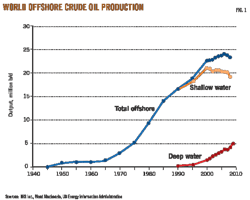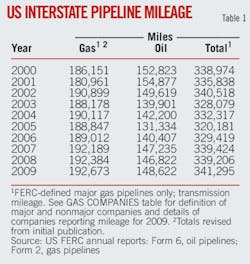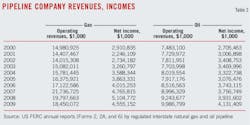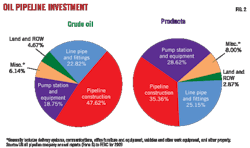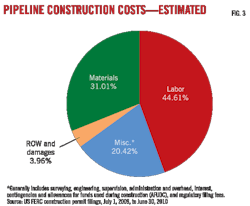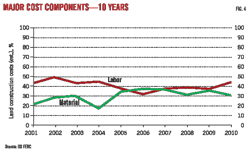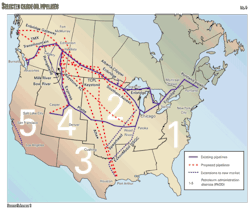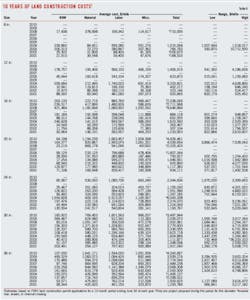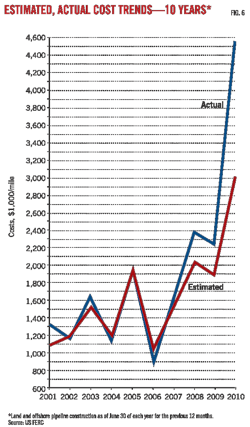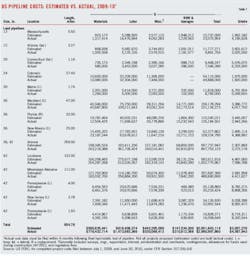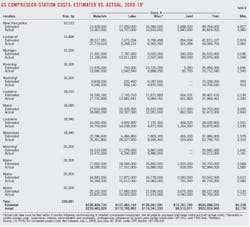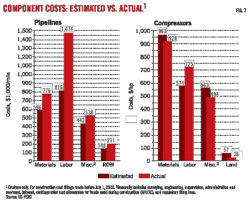Christopher E. Smith
Pipeline Editor
Natural gas pipeline operators in 2009 saw their profits drop to lows not seen since 2006, falling nearly 9% despite the lesser 4.27% drop in revenues. Net profits totaled $4.7 billion against revenues of $19 billion (Fig. 1).
The resulting earnings as a percent of revenue of 24.57% eased from record highs achieved in 2008. Oil pipelines, by contrast, experienced growth in profits and revenues of 5% and 8%, respectively (Fig. 1).
Natural gas pipeline companies continued to grow despite the lower earnings, with additions to plant totaling more than $15.6 billion (a 28.51% increase from 2008) while expenditures on operations and maintenance fell more than 23% to slightly less than $6 billion.
Operators also pulled back on planned capacity expansions. Proposed newbuild mileage was less then 25% of 2009's announced build, with planned horsepower additions of 199,833 hp standing at roughly 30% of 2009's total.
The diminished quantity of proposed pipeline mileage coincided with continued upward momentum in labor costs, as reflected in data OGJ gathered for the 12 months ending in June 30, 2010. Overall estimated $/mile pipeline costs rose nearly 37% to more than $5 million. Pipeline labor prices expanded their premium to material and miscellaneous costs as the single most expensive per-mile item, rising more than 60% to more than $2.3 million/mile.
Higher-cost labor also affected the balance between estimated and actual costs for both pipeline and compressor projects completed in the 12 months ending in June 30. Actual land pipeline costs exceeded projected costs by more than $1.5 million/mile, with a $1 million/mile difference in labor costs leading the way. Higher than anticipated labor costs were also the only factor countering generally softer compressor costs, with projects completed by June 30, running $50/hp less expensive than had been predicted as materials, land, and miscellaneous costs all fell.
US pipeline data
At the end of this article, two large tables (beginning on p. 117 offer a variety of data for US oil and gas pipeline companies: revenue, income, volumes transported, miles operated, and investments in physical plants. These data are gathered from annual reports filed with the US Federal Energy Regulatory Commission by regulated oil and natural gas pipeline companies for the previous calendar year.
Data are also gathered from periodic filings with FERC by those regulated natural gas pipeline companies seeking approval to expand capacity. OGJ keeps a record of these filings for each 12-month period ending June 30.
Combined, these data enable an analysis of the US regulated interstate pipeline system.
• Annual reports. Companies that, in FERC's determination, are involved in the interstate movement of oil or natural gas for a fee are jurisdictional to FERC, must apply to FERC for approval of transportation rates, and therefore must file a FERC annual report: Form 2 or 2A, respectively, for major or nonmajor natural gas pipelines; Form 6 for oil (crude or product) pipelines.
The distinction between "major" and "nonmajor" is defined by FERC and appears as a note at the end of the table listing all FERC-regulated natural gas pipeline companies for 2009 at the end of this article (p. 121).
The deadline to file these reports each year is Apr. 1. For a variety of reasons, a number of companies miss that deadline and apply for extensions, but eventually file an annual report. That deadline and the numerous delayed filings explain why publication of this OGJ report on pipeline economics occurs later in each year. Earlier publication would exclude many companies' information.
• Periodic reports. When a FERC-regulated natural gas pipeline company wants to modify its system, it must apply for a "certificate of public convenience and necessity." This filing must explain in detail the planned construction, justify it, and—except in certain instances—specify what the company estimates construction will cost.
Not all applications are approved. Not all that are approved are built. But, assuming a company receives its certificate and builds its facilities, it must—again, with some exceptions—report back to FERC how its original cost estimates compared with what it actually spent.
OGJ spends the year July 1 to June 30 monitoring these filings, collecting them, and analyzing their numbers.
OGJ's exclusive, annual Pipeline Economics Report began tracking volumes of gas transported for a fee by major interstate pipelines for 1987 (OGJ, Nov. 28, 1988, p. 33) as pipelines moved gradually after 1984 from owning the gas they moved to mostly providing transportation services.
Volumes of natural gas sold by pipelines have been steadily declining, so that, beginning with 2001 data in the 2002 report, the table only lists volumes transported for others.
The company tables also reflect asset consolidation and mergers among companies in their efforts to improve transportation efficiencies and bottom lines.
Reporting changes
The number of companies required to file annual reports with FERC may change from year to year, with some companies becoming jurisdictional, others nonjurisdictional, and still others merging or being consolidated out of existence.
Such changes require that care be taken in comparing annual US petroleum and natural gas pipeline statistics.
Institution by FERC of the two-tiered (2 and 2A) classification system for natural gas pipeline companies after 1984 further complicated comparisons (OGJ, Nov. 25, 1985, p. 55).
Only major gas pipelines are required to file miles operated in a given year. The other companies may indicate miles operated but are not specifically required to do so.
For several years after 1984, many nonmajors did not describe their systems. But filing descriptions of their systems has become standard, and most provide miles operated.
Reports for 2009 show an increase in FERC-defined major gas pipeline companies: 86 companies of 136 filing for 2009, from 83 of 130 for 2008.
The FERC made an additional change to reporting requirements for 1995 for both crude oil and petroleum products pipelines. Exempt from requirements to prepare and file a Form 6 were those pipelines with operating revenues at or less than $350,000 for each of the 3 preceding calendar years. These companies must instead file an "Annual Cost of Service Based Analysis Schedule," which provides only total annual cost of service, actual operating revenues, and total throughput in both deliveries and barrel-miles.
In 1996 major natural gas pipeline companies were no longer required to report miles of gathering and storage systems separately from transmission. Thus, total miles operated for gas pipelines consist almost entirely of transmission mileage.
FERC-regulated major natural gas pipeline mileage edged higher in 2009 (Table 1), reaching its highest level since 1995. Final data show an increase of 289 miles, or 0.15%.
Rankings; activity
Natural gas pipeline companies in 2009 saw operating revenues drop by more than $736 million, or nearly 4% from 2008. Net incomes fell by more than $472 million, or more than 9%.
Oil pipelines, however, saw earnings rise nearly $200 million (5%) on the back of a more than $743 million (8%) increase in revenues. Operators, however, kept their profits close at hand, property changes slowing by more than $934 million (21%; Table 2).
Crude throughput for 2009, measured in million bbl-miles (bbl-mile: 1 bbl moving 1 mile) dropped more than 119 million bbl-miles, or 7.55%, more than countering an 18.7 million bbl-mile increase in products traffic.
OGJ uses the FERC annual report data to rank the top 10 pipeline companies in three categories (miles operated, trunkline traffic, and operating income) for oil-pipeline companies and three categories (miles operated, gas transported for others, and net income) for natural gas pipeline companies.
Positions in these rankings shift year to year, reflecting normal fluctuations in companies' activities and fortunes. But also, because these companies comprise such a large portion of their respective groups, the listings provide snapshots of overall industry trends and events.
For instance, the growth in liquids pipeline earnings was driven by the top 10 companies in the segment, for which incomes rose a combined $200 million as their share of the segment's total earnings expanded to 63.37%. Earnings at Enbridge Energy LP alone rose more than $110 million (46.6%).
Company financial data provide a view of the ongoing condition of the oil and gas pipeline industries.
For all natural gas pipeline companies, for example, net income as a portion of operating revenues fell to 24.57% in 2009 after reaching record highs in 2008 (25.78%).
The percentage of income as operating revenues for oil pipelines also slipped in 2009, hitting 41.37% (below 2007 levels) after reaching 42.53% in 2008.
Net income as a portion of gas-plant investment plunged to 3.84% after having peaked at 4.99% in 2007 and largely maintaining those levels last year. The 2009 figure was the lowest in at least 15 years of OGJ tracking.
For oil pipelines, net income as a portion of investment in carrier property in 2009 fell to 9.9%, despite increased earnings, continuing a drop from the 11.5% reached in 2006. Income as part of investment in carrier property in 2004 stood at 11.4%, having risen steadily toward that level from 6.8% in 1998.
Major and nonmajor natural gas pipelines in 2009 reported an industry gas-plant investment of nearly $121.3 billion, the highest level ever, up from nearly $105.8 billion in 2008, $95.5 billion in 2007, $88.3 billion in 2006, $84 billion in 2005, more than $83 billion in 2004, nearly $78 billion in 2003, $74.2 billion in 2002, almost $71 billion in 2001, and $68 billion in 2000.
Investment in oil pipeline carrier property also continued to rise in 2009, reaching $41.6 billion, after hitting $39.1 billion in 2008, almost $35.9 billion in 2007, and a rebound to $32.7 billion in 2006 from the lowest level seen since at least 1997, $29.5 billion in 2005.
OGJ for many years has tracked carrier-property investment by five crude oil pipeline and five products pipeline companies chosen as representative in terms of physical systems and expenditures (Table 3). In 2003, we added the base carrier-property investment to allow for comparisons among the anonymous companies.
The five crude oil pipeline companies in 2009 increased their overall investment in carrier property by nearly $1.1 billion (roughly 24%); the same grouping of companies increased investment in carrier property in 2008 by more than $1.4 billion, or nearly 44%. In both years all of the companies in the group increased their investment, but the bulk of the increase each time came as a result of increased construction expenditures at the largest company.
The five products pipeline companies, by contrast, increased overall investment in carrier property by $325 million, or 5.2%, up from the $234 million, or 3.89%, increase of 2008. As with the crude oil lines, all companies in the products pipeline group increased investment in 2008.
Total investment by the five product pipeline companies in 2009 was nearly $6.6 billion, continuing a return to growth started in 2003 when investment of more than $4.7 billion was up from 2002's $4.5 billion level.
Comparisons of data in Table 3 with previous years must be done with caution: In 2004, for instance, a major crude oil pipeline company listed there sold significant assets, complicating comparisons with previous years' data.
Fig. 2 illustrates the investment split in the crude oil and products pipeline companies.
Construction surges
Applications to FERC by regulated interstate natural gas pipeline companies to modify certain systems must, except in certain instances, provide estimated costs of these modifications in varying degrees of details.
Tracking the mileage and compression horsepower applied for and the estimated costs can indicate levels of construction activity over 2-4 years. OGJ has been doing that since this report began more than 50 years ago.
Tables 4 and 5 show companies' estimates during the period July 1, 2009, to June 30, 2010, for what it will cost to construct a pipeline or install new or additional compression.
These tables cover a variety of locations, pipeline sizes, and compressor-horsepower ratings.
Not all projects proposed are approved. And not all projects approved are eventually built.
Applications filed in the 12 months ending June 30, 2010, fell sharply after surging the previous year.
• More than 524 miles of pipeline were proposed for land construction, and no new offshore work. The land level is down from the roughly 2,180 miles proposed for construction in 2009, which was the highest level since more than 2,700 miles were proposed in 1998.
• New or additional compression proposed by the end of June 2010 measured nearly 200,000 hp, down substantially from the 664,775 hp proposed in 2009 and even below the 238,400 hp proposed in 2008.
Putting the downturn in US gas pipeline construction in perspective, Table 4 lists 8 land-pipeline "spreads," or mileage segments, and no marine projects, compared with:
• 21 land and 0 marine projects (OGJ, Sept. 14, 2009, p. 66).
• 19 land and 0 marine projects (OGJ, Sept. 1, 2008, p. 58).
• 25 land and 1 marine project (OGJ, Sept. 3, 2007, p. 51).
• 42 land and 1 marine project (OGJ, Sept. 11, 2006, p. 46).
• 56 land and 4 marine projects (OGJ, Sept. 12, 2005, p. 50).
• 15 land and 0 marine projects (OGJ, Aug. 23, 2004, p. 60).
• 37 land and 3 marine projects (OGJ, Sept. 8, 2003, p. 60).
• 83 land and 3 marine projects (OGJ, Sept. 16, 2002, p. 52).
• 49 land and 2 marine projects (OGJ, Sept. 3, 2001, p. 66).
• 115 land and 6 marine projects (OGJ, Sept. 4, 2000, p. 68).
The drop in both mileage and spread growth in 2010 shows that most of the few projects proposed are small, with only 2 of the 8 measuring 100 miles or more and none measuring more than 300 miles.
For the 12 months ending June 30, 2010, 8 land projects cost nearly $2.7 billion, as compared with the slightly more than $8.1 billion for 21 projects a year earlier.
It is helpful to remember that these statistics cover only FERC-regulated pipelines. Many other pipeline construction projects were announced in the 12 months ending June 20, 2010, but more often than not these projects involved connecting developing natural gas shale plays such as Eagle Ford and Marcellus to already operating transportation infrastructure.
Estimated $/mile costs for the new projects continued to rise. For proposed onshore US gas pipeline projects in 2009-10, the average cost was $5.096 million/mile; in 2008-09 the average onshore cost was $3.728 million/mile; in 2007-08, the average onshore cost was $3.381 million/mile; in 2006-07, the average onshore cost was $2.775 million/mile; and for 2005-06, the average onshore cost was $1.95 million/mile.
Cost components
Variations over time in the four major categories of pipeline construction costs—material, labor, miscellaneous, and right-of-way (ROW)—can also suggest trends within each group.
Materials can include line pipe, pipe coating, and cathodic protection.
"Miscellaneous" costs generally cover surveying, engineering, supervision, contingencies, telecommunications equipment, freight, taxes, allowances for funds used during construction (AFUDC), administration and overheads, and regulatory filing fees.
ROW costs include obtaining rights-of-way and allowing for damages.
For the eight land spreads filed for in 2009-10, costs-per-mile projections for three of the four categories showed increases, with only ROW charges easing:
• Material—$1,580,483/mile, up from $1,310,611/mile for 2008-09.
• Labor—$2,273,151/mile, up from $1,414,832/mile for 2008-09.
• Miscellaneous—$1,040,598/mile, up from $758,757/mile for 2008-09.
• ROW and damages—$201,641/mile, down from $242,334/mile for 2008-09.
Table 4 lists proposed pipelines in order of increasing size (OD) and increasing lengths within each size.
The average cost-per-mile for the projects rarely shows clear-cut trends related to either length or geographic area. In general, however, the cost-per-mile within a given diameter decreases as the number of miles rises. Lines built nearer populated areas also tend to have higher unit costs.
Additionally, road, highway, river, or channel crossings and marshy or rocky terrain each strongly affect pipeline construction costs. Fig. 3, derived from Table 4, shows the major cost-component splits for pipeline construction costs.
Surging labor costs expanded its position as the single largest portion of land construction costs. Labor's portion of estimated costs for land pipelines rose to 44.61% in 2010, from 37.95% in 2009, 39.76% in 2008, 37.93% in 2007, and 32.35% in 2006. Material costs for land pipelines also continued to rise in absolute terms, although the sharply higher labor prices saw its share of total costs shrink to 31.01% in 2010 as compared with 35.19% of total costs in 2009, 30.93% in 2008, 36.44% in 2007 and 38.17% in 2006.
Fig. 4 plots a 10-year comparison of land-construction unit costs for the two major components, material and labor.
Fig. 5 shows the cost split for land compressor stations based on data in Table 5.
Table 6 lists 10 years of unit land-construction costs for natural gas pipeline with diameters ranging from 8 to 36 in. The table's data consist of estimated costs filed under CP dockets with FERC, the same data shown in Tables 4 and 5.
Table 6 shows that the average cost-per-mile for any given diameter may fluctuate year to year as projects' costs are affected by geographic location, terrain, population density, or other factors.
Completed projects' costs
In most instances, a natural gas pipeline company must file with FERC what it has actually spent on an approved and built project. This filing must occur within 6 months following the pipeline's successful hydrostatic testing or the compressor's being put in service.
Fig. 6 shows 10 years of estimated vs. actual costs on cost-per-mile bases for project totals.
Tables 7 and 8 show such actual costs for pipeline and compressor projects reported to FERC during the 12 months ending June 30, 2010. Fig. 7, for the same period, depicts how total actual costs ($/mile) for each category compare with estimated costs.
Per-mile pipeline construction costs for completed projects more than doubled in 2010, after falling by nearly 6.4% a year earlier.
Actual labor costs for pipeline construction were more than $1 million/mile higher than estimated costs for the same projects. Overall actual costs were 49.4% higher than projected costs for the 12 months ending June 30, 2010, with the price of labor running 80.5% higher than had been anticipated.
Some of these projects may have been proposed and even approved much earlier than the 1-year survey period. Others may have been filed for, approved, and built during the survey period.
If a project was reported in construction spreads in its initial filing, that's how projects are broken out in Table 4. Completed projects' cost data, however, are typically reported to FERC for an entire filing, usually but not always separating pipeline from compressor-station (or metering site) costs and lumping various diameters together.
The 12 months ending June 30, 2010, saw nearly 240,000 hp of new or additional compression completed, down from the more than 295,000 hp seen the year before but still higher than any other year since the 468,000 hp posted in 2004.
Horsepower additions were concentrated in the Northeast, Gulf coast, and Mountain West.
In contrast to pipelines, actual compression costs ran $50/hp lower than estimates, with softening in other cost components compensating for labor costs, which ran more than 26% higher than initial estimates (Table 8). Despite being lower than anticipated, however, $/hp actual costs still rose 31% from 2009.
Click here to download the pdf of the Oil Pipelines Companies
Click here to download the pdf of the Gas Pipelines Companies
More Oil & Gas Journal Current Issue Articles
More Oil & Gas Journal Archives Issue Articles
View Oil and Gas Articles on PennEnergy.com

